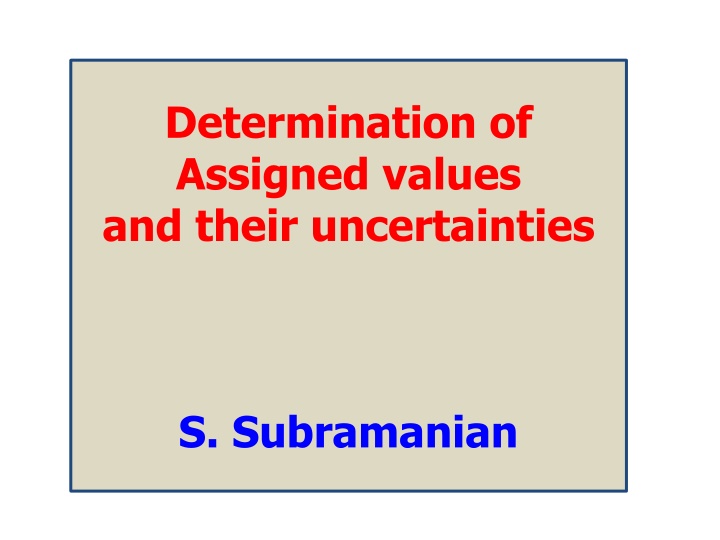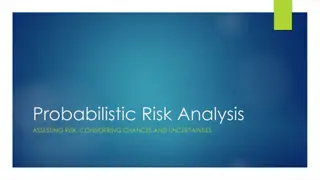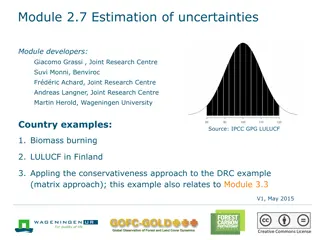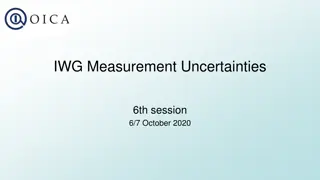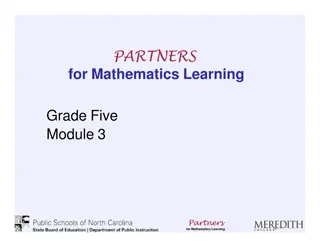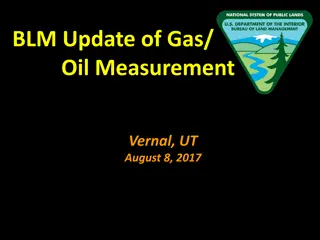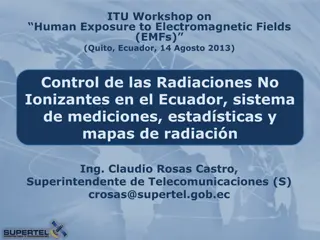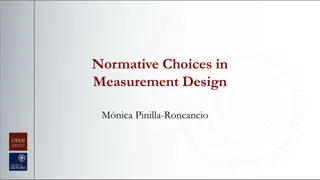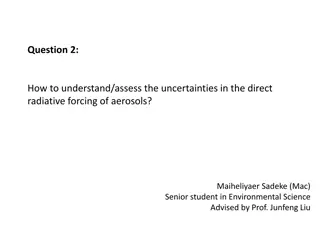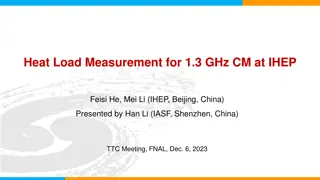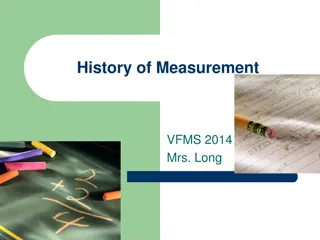Assigned Values and Uncertainties in Measurement
In the world of measurement, understanding assigned values and their uncertainties is crucial for accuracy and reliability. This article discusses different sources of assigned values, methods of determination, and considerations for calculation of uncertainties. From known values in formulations to competency in proficiency testing, explore the intricacies of deriving and validating assigned values in measurements.
Download Presentation

Please find below an Image/Link to download the presentation.
The content on the website is provided AS IS for your information and personal use only. It may not be sold, licensed, or shared on other websites without obtaining consent from the author.If you encounter any issues during the download, it is possible that the publisher has removed the file from their server.
You are allowed to download the files provided on this website for personal or commercial use, subject to the condition that they are used lawfully. All files are the property of their respective owners.
The content on the website is provided AS IS for your information and personal use only. It may not be sold, licensed, or shared on other websites without obtaining consent from the author.
E N D
Presentation Transcript
Determination of Assigned values and their uncertainties S. Subramanian
According to the standards and guidelines mentioned, following possibilities for the assigned value are given in the increasing order of Uncertainty of Assigned Value xpt Known values from formulation Certified reference Material Results from one Lab Consensus values from expert laboratories Consensus values from participant results Regardless of method used to derive A.V, check the validity of A.V for each round 2 24-02-2025 S.SUBRAMANIAN
Uncertainty of Assigned Value u(xpt) Competent proficiency test provider should report the uncertainty of the assigned value Participants need it For judgement of their performance For estimation of measurement uncertainty from PT data PT Provider should have criteria for acceptability of an Assigned Value in terms of its uncertainty i.e u(xpt) 0.3 SDPA 3 24-02-2025 S.SUBRAMANIAN
Known values from formulation 7.3 (ISO 13528) If a sample is prepared synthetically by mixing constituents in specified proportions or by adding a specified quantity of a substance to a base material (e.g) cement content of hardened concrete (cement, aggregate and water are mixed at definite proportion) The assigned value is derived by calculation from the masses used Caution: The analyte might be more loosely bound than in typical materials 4 24-02-2025 S.SUBRAMANIAN
Known values from formulation 7.3 CARE TO BE TAKEN WHILE PREPARING PT ITEMS Base material free from added constituent Constituents mixed homogeneously All significant sources of error are identified No adverse interaction between constituents Behaviour of PT items prepared is similar to routinely tested samples 5 24-02-2025 S.SUBRAMANIAN
Known values from formulation 7.3 Measurement Uncertainty Calculation of an uncertainty budget according to GUM including all volumetric and gravimetric steps other uncertainty contributions, e.g. From Purity of substances In-homogeneity Instability Adsorption Reaction with constituents in the base material Concentration of analyte in the base material based on the law of uncertainty propagation 6 24-02-2025 S.SUBRAMANIAN
Known values from formulation 7.3 Advantages/disadvantages Advantage If the analytical method is biased or the participating labs are biased on average it will be a better estimate for the true value Uncertainty generally is lowest If all uncertainty contributions are covered and the purity of the substances is well defined, the assigned value might be traceable to SI Disadvantage If the analyte is more loosely bound than in typical materials, the difficulty of the analysis might be lower (not representative) If there is unrecognized instability, adsorption or reaction with matrix constituents the assigned value will be biased 7 24-02-2025 S.SUBRAMANIAN
Certified reference Materials 7.4 (ISO 13528) If the PT material is a Certified Reference Material the certified value can be used 8 24-02-2025 S.SUBRAMANIAN
Certified reference Materials 7.4 Uncertainty Usage of the uncertainty from the certificate Caution: Certificates may report uncertainties on a different confidence level (coverage factor) 9 24-02-2025 S.SUBRAMANIAN
Certified reference Materials 7.4 Advantages/disadvantages Advantage Traceability Second lowest uncertainty Disadvantage Might be expensive Suitable CRMs might not be available A CRM may be known to participant Important to conceal the identity of PT item CRMs are often processed heavily to ensure long term stability which may compromise commutability of samples 10 24-02-2025 S.SUBRAMANIAN
Results from one Laboratory 7.5 Preparation of a reference material- as per ISO 17034:2016 A number of test portions are randomly selected: Analysis in one lab under repeatability conditions together with a certified reference material Analysis with a primary method The assigned value is derived: from a calibration against the certified reference value from the results of the primary method 11 24-02-2025 S.SUBRAMANIAN
Results from one Laboratory 7.5 The assigned value is derived from formula: xpt = xCRM + Average d Average d = Average of the difference (RM CRM) for each of the n results (take sign also into consideration) 12 24-02-2025 S.SUBRAMANIAN
Results from one Laboratory 7.5 Measurement Uncertainty When a suitable CRM is not available for calibrating/characterizing the RM, Reference Value can be obtained from an appropriate source Ensure metrologocal traceability & Measurement uncertainty needed If the samples and the CRM are not similar (in matrix, composition and level of results), the additional uncertainty arising from this is also to be included 13 24-02-2025 S.SUBRAMANIAN
Results from one Laboratory 7.5 Measurement Uncertainty The assigned value is derived from formula: u(xpt)= SQRT(u2CRM + u2d ) uCRM= Std. uncertainty derived from the certificate of the CRM ud= Standard Error of the n differences Combination of the uncertainty of the certified reference value with the uncertainty of the measurements 14 24-02-2025 S.SUBRAMANIAN
Results from one Laboratory 7.5 Advantages/disadvantages Advantage Might be traceable to SI through the CRM or the primary method Third lowest uncertainty uncertainty Not as expensive as direct usage of CRM Disadvantage It is assumed that there are no interactions between materials used and the test conditions CRMs that are similar enough to test samples in the required matrix and concentration are often not available Primary method is not available Results are dependent of one laboratory 15 24-02-2025 S.SUBRAMANIAN
Consensus values from expert laboratories 7.6 Samples are prepared and distributed to expert laboratories first (Similar to approach of ISO Guide 35 CRM characterization) The results of the expert laboratories are used to estimate Robust Mean using Algorithm A No. of expert labs will normally be small -6 or 8. Hence, use the method with caution 16 24-02-2025 S.SUBRAMANIAN
17 24-02-2025 S.SUBRAMANIAN
18 24-02-2025 S.SUBRAMANIAN
Consensus values from participants 7.7 Consensus Values from (a) All participants or (b) Expert participants If expert participants predefined criteria such as accreditation status or on the basis of previous performance Algorithm A for determining Assigned Value 19 24-02-2025 S.SUBRAMANIAN
As Assigned Value and Robust SD are determined from participant results, Uncertainty of Assigned Value can be assumed to include the effects of uncertainty due to in-homogeneity, transport & instability 20 24-02-2025 S.SUBRAMANIAN
21 24-02-2025 S.SUBRAMANIAN
